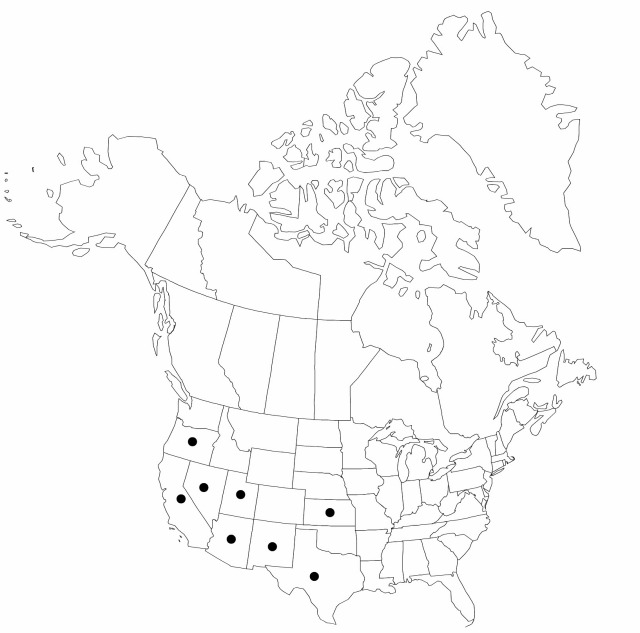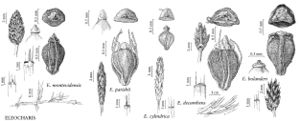Eleocharis parishii
J. New York Microscop. Soc. 5: 110. 1889.
Plants perennial, mat-forming; rhizomes evident, long, 0.5–1(–2) mm thick, firm, cortex persistent, longer internodes 5–30 mm, scales often fugaceous, 5–10 mm, membranous, not fibrous. Culms terete or cross section elliptic (or rectangular), usually with to 8 blunt ridges when dry, 10–50 cm × 0.2–0.7(–1) mm, soft to firm, spongy. Leaves: distal leaf sheaths persistent, not splitting, mostly proximally dark red, distally red to brown or green, thinly papery to thickly membranous, apex usually redbrown, subtruncate to obtuse or subacute, callose, tooth often present on most or all culms, to 1 mm. Spikelets narrowly lanceoloid (to narrowly cylindric), 3–20 × 1.5–2.5 mm, apex acute; proximal scale amplexicaulous, entire; subproximal scale empty or with flower; floral scales appressed or spreading in fruit, 15–40, 3–4 per mm of rachilla, orange brown, midrib regions often greenish, ovate, 2–3 × 1 mm, apex entire, rounded to obtuse in proximal part of spikelet, acute in distal part, carinate, at least in distal part of spikelet. Flowers: perianth bristles 3–7, rarely apparently absent, stramineous to whitish, slender to stout, often unequal, rudimentary to slightly exceeding tubercle; stamens 3; anthers yellow to stramineous, 1.1–2 mm; styles 3-fid, 0.3–0.4 × 0.2–0.3 mm. Achenes falling with scales, yellow-brown or dark brown, ellipsoid or obovoid to obpyriform, compressed-trigonous, angles evident to obscure, rarely prominent, 0.8–1.4 × 0.5–0.7 mm, neck absent to long, smooth or sometimes minutely cancellate at 20–30X. Tubercles whitish, pyramidal, often higher than wide, 0.3–0.4 × 0.25–0.35 mm. 2n = 10.
Phenology: Fruiting spring–fall.
Habitat: Fresh to brackish, wet soil or emergent, often drying lakeshores, ponds, streams, springs
Elevation: 500–2300 m
Distribution

Ariz., Calif., Kans., Nev., N.Mex., Oreg., Tex., Utah, Mexico.
Discussion
Eleocharis parishii is very similar to E. montevidensis, with which it sometimes grows. It differs from E. montevidensis mainly in its narrowly lanceoloid to cylindric spikelets and its floral scale apices not recurved or horizontally wrinkled. Some apparent intermediates occur in regions of sympatry. The floral scales of E. montevidensis are more densely placed on the rachilla.
Selected References
None.
